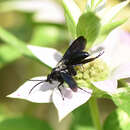Comprehensive Description
provided by Memoirs of the American Entomological Society
Paracyphononyx funereus (Lepeletier)
Anoplius funereus Lepeletier, 1845, Hist. Nat. Insectes, Hymen., Ill, p. 449
[Type: S, Pennsylvania: Philadelphia (not seen by writer)]. Pompilus maurus Cresson, 1867, Trans. Amer. Ent. Soc, 1: 88 [Type: 5,
West Virginia (ANSP, no. 414)]. Allocyphonyx maurus Ashmead, 1902, Canad. Ent., 34: 136. — Bradley, 1944,
Trans. Amer. Ent. Soc, 70: 152. Psammochares {Allocyphonyx) harpalyce Banks, 1910, Psyche, 17: 250 [Type:
2, North Carolina: Southern Pines, 26 July 1909 (A. H. Manee)
(MCZ, no. 13, 710)]. Paracyphononyx funereus Evans, 1951, Trans. Amer. Ent. Soc, 77: 306-308.
Female. — Length 11-20 mm. Black; wings wholly fuliginous, somewhat violaceous. Pubescence mostly dark, with obscure bluish reflections, on the occiput and often also on the front grayish or somewhat glaucous. Head and propodeum with some short, dark hair; thoracic dorsum, pleura, and coxae often with sparse, short hair; abdomen setose ventrally and apically. Clypeus about twice as broad as high; malar space fairly long, nearly as long as the antennal pedicel and at least a third as long as the width of the mandibles at their base. MID varying from .51 to .58 X TFD; UID varying from .90 to 1.0 X LID; POL usually somewhat exceeding OOL; third antennal segment equal to from .7 to .9 X UID. Pronotum rather long, subangulate behind; propodeum with an abrupt, flat declivity on the posterior fourth. Ultimate tarsal segments smooth beneath, except apically. SMC3 subtriangular (fig. 24).
Male. — Length 8-19 mm. Black, except scape sometimes whitish below and apical tergite sometimes whitish; wings wholly infuscated, somewhat darker along the outer margin, often violaceous. Pubescence mostly dark as in the female, except grayish or somewhat silvery on the occiput, usually over much of the head, occasionally on parts of the pronotum, scutellum, pleura, coxae, and basal bands on some of the abdominal tergites; metanotum and propodeal declivity with coarse, erect pubescence, usually dark but sometimes more or less silvery. Malar space slightly longer than in the female; inner orbits slightly diverging above, UID slightly exceeding LID; POL usually somewhat exceeding OOL. Third antennal segment 2.5-3.0 X as long as thick; segment four slightly thickened and subangulate toward the base below, segments 5-12 rather strongly so, these segments generally 1.3 to 2.0 X as long as their maximum thickness. Last segment of front tarsus slightly asymmetrical. SGP rounded or subtruncate apically, bearing some stout apical setae, internally on each side of the base with strong lateral flanges which bear setae (somewhat variable, but usually approximating fig. 249 in Evans, 1951). Genitalia also somewhat variable, but the parameres always broader apically than at their base and fringed with long setae; digiti elongate, with a median area devoid of setae (fig. 194 in Evans, 1951).
Distribution. — This species ranges from Jalisco, Yucatan, and southern Florida to Massachusetts, Michigan, and Utah. Mexican records (except Yucatan) are from the central plateau. (Map 80.)
Mexican specimens examined. — 15 92, 23 8 8. Coahuila: 1 8 , Buena Vista, Sierra del Carmen, 7 July [CIS]. Chihuahua: 2 5 2,6 8 8 , Matachic & vie, 6400 feet, July-Aug. [AMNH]; 1 8 , 18 mi. W Chihuahua, 12 Aug. 1951 (PDH) [CIS]; 3 2 5,3 $ $, 18 mi. W Jimenez, 10 Aug. 1951 (HEE) [MCZ]; 3 2 2,2 8 8, Santa Clara, 2 July 1947 (WG, CDM) [AMNH]; 1 8 , 12 mi. NW Gran Morelos, 15 Aug. 1956 (RFS) [AMNH]. Durango: 1 <5 , 8 mi. S Canutillo, 9 Aug. 1951 (HEE) [MCZ]; 1 2 , Palos Colorados, 8000 feet, 5 Aug. 1947 (MC) [AMNH]. Zacatecas: 1 2 , 1 mi. N San Jose de Felix, 14 July 1954 (EIS) [CIS]; 1 2 , 2 8 8 , 15 km. E Sombrerete, 28-31 July 1951 (HEE, PDH) [MCZ, CIS]; 1 2, 1 8 , 9 mi. N Ojo Caliente, 12 May 1962 (FDP) [UCD]. Jalisco: 1 2, 13 mi. SW Lagos de Moreno, 4 Aug. 1954 (JWM) [CIS]. Hidalgo: 3 8 8 , Jacala, 4500 feet, 1 Sept. 1963 (HAS) [OSU]. San Luis Potosi: 1 2,1 8 , 18 mi. SW San Luis Potosi, 7300 feet, 1 Oct. 1957 (HAS) [OSU]. Yucatan: 1 2,1 8 , Merida & vie, 17-25 July 1962 (HEE) [MCZ].
Variation. — The discovery of this species in Yucatan, close to sea level, came as a surprise, since it otherwise occurs in the central plateau, up to 8000 feet. Central plateau material all has reduced pale pubescence and is closely similar to material from Texas. The female from Yucatan has an unusually narrow front, while the male has a fairly extensive pattern of pale pubescence and also has the scape pale beneath and the apical tergite whitish; the parameres of
© Paracyphononyx funereus (Lepeletier) {also widely distr. in U.S.)
A P. unicolor (Smith)
(also widely distr. in So. America)
m P. semiplumbeus (Taschenberg)
(also widely distr. in So. America)
this male are more acute apically than is common in this species. All of this suggests an affinity with the eastern U. S. populations (especially Florida). It is perhaps worth noting that there is regular jet air transport between Miami and Merida, and the specimens from Yucatan were collected within a 20 km. radius of the airport in Merida (one, in fact, within 1 km.).
- bibliographic citation
- Evans, H.E. 1966. A Revision of the Mexican and Central American Spider Wasps of the Subfamily Pompilinae (Hymenoptera: Pompilidae). Memoirs of the American Entomological Society vol. 20. Philadelphia, USA

